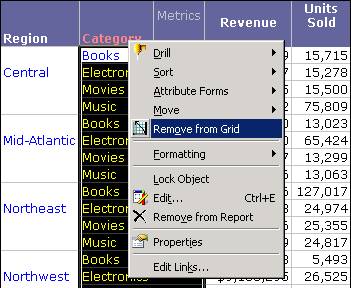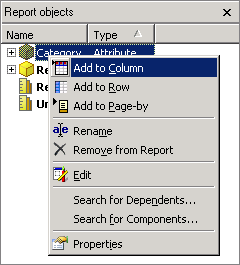MicroStrategy ONE
Using dynamic aggregation
To change the aggregation level of a report, you must either remove an attribute from a report entirely, or use dynamic aggregation to remove the attribute from the report grid only. With dynamic aggregation, the attribute is still a part of the report definition and is included in the Report Objects.
To use dynamic aggregation, right-click an attribute on a report grid and select Remove from Grid, as shown below.

Be careful not to select Remove from Report. If you select this option, the attribute is completely removed from the report definition, and the report is re-executed against the data warehouse.
You need the Use Report Objects Window (Developer) and/or the Web Use Report Objects Window (Web) privileges to use dynamic aggregation. These privileges are part of OLAP Services.
Another benefit of using dynamic aggregation is that the attributes removed from the report grid can be easily included back onto the report grid or page-by area. To do this, right-click an attribute in the Report Objects pane and select Add to Column, Add to Row, or Add to Page-by to add an attribute from the Report Objects pane onto the report. The options to move an attribute to the report are shown in the image below.

You can also move attribute forms between the Report Objects pane and the report grid. If you only move an attribute form and not the attribute itself, dynamic aggregation is not triggered. For example, if the attribute forms Last Name and First Name for the attribute Customer are displayed on a report, you can move First Name to the Report Objects pane without triggering dynamic aggregation. The same First Name attribute form can be moved back to the report grid without triggering dynamic aggregation.
An attribute must have at least one attribute form displayed to be on the report grid.
